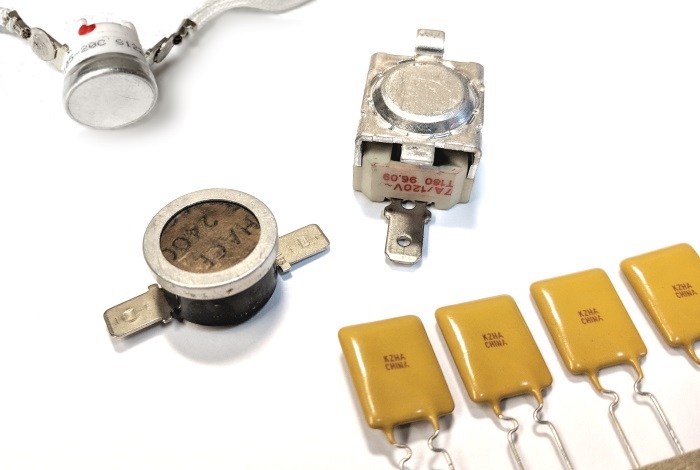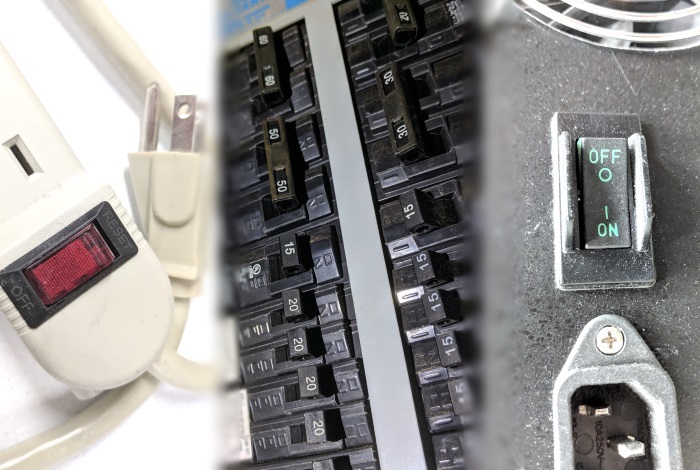or, How to Understand and Apply Circuit Protective Devices
SELF-RESETTING DEVICES
Let us dispense with these at once: self-resetting devices should never be used as primary protection, and are best suited to low-cost control circuits and limited forms of secondary protection. Fault conditions in hobby gear, especially on the mains side, are rarely temporary and any automatic reset invites disaster. Devices in this category include the mechanical thermal switch, the self-resetting fuse, and the thermistor, a strongly temperature-sensitive resitive device also known as a polyswitch.

Figure 5. Typical self-resetting mechanical thermal switches (upper and middle), and polyswitches (lower right).
Mechanical switch devices rely on external heating and use a plate that deforms at a setpoint temperature to trip a switch. These are common as the thermostat control in heating appliances such as coffee makers. When obtained with a suitable temperature rating, they can also control cooling fans in amplifiers and the like or temporarily disconnect power until the equipment has cooled. They have a long service life but are prone to eventual wear-out, and tend to be backed up by a thermal fuse whenever uncontrolled heating is a possibility.
The self-resetting fuse has a bimetallic strip in the circuit path that heats under overload and opens, then closes the circuit again after cooling. These are best avoided in hobby projects unless a very specific application requires it, and there is some other upstream protection in place.
A typical polyswitch voltage rating is less than full mains, and the device may short and then flame out under long term use in such application. The positive coefficient mainly applied as speaker protection circuits and should mostly stay there. Another application uses the negative-coefficient version as a series ballast for transformer soft-starting, either directly with careful calculations to keep it hot and invisible under normal load currents into the transformer, or with a bypass relay.
In short, one secret to a happy DIY life is to never use self-resetting devices for primary protection, especially for any devices using mains voltage. And to then be aware of their limitations when using them anywhere else.
CIRCUIT BREAKERS
The circuit breaker is a manually-resettable device which improves on the fuse anywhere temporary faults may occur. Fuses usually have the lowest initial cost, but fuses that need frequent service can become expensive and troublesome compared to a circuit breaker that resets by lever or button.

Figure 6. Common circuit breaker applications (from left): thermal-breaker in a power strip switch,
thermal-magnetic breakers installed in a load center, magnetic breaker in an amplifier chassis.
An overcurrrent breaker can be a thermal type, a magnetic type, or both. Figure 6 shows possible applications. As a rule-of-thumb, a thermal breaker is cheap and provides a good substitute for a time-delay fuse, a magnetic breaker behaves a lot like a fast-acting fuse, and a hybrid device provides the best of both types at the highest cost. Breakers may be trip-only devices (usually with a push-button reset) or combine an "off" position that the user can switch. A modern power strip switch is a common application of a thermal breaker inside a traditional switch body.
The thermal element uses a bimetallic strip to release a catch. If overloaded, the strip is heated either directly by through-current or indirectly by a series resistive element until the resulting tension pulls the strip free of a spring-catch. A thermal trip requires a cool-down time before the device can be reset. Also, the series resistance in some designs be rather high. The magnetic-type element uses an electromagnet coil in series with the load, where a very high current will pull open a spring-catch. Series resistance is normally very low but nuisance tripping might be a problem in some applications. A magnetic trip is immediately resettable.
Breakers in a mains load center (circuit distribution panel) are usually hybrid type. A thermal element trips for long-time overloads anywhere from a few seconds to a minute or so, but avoids nuisance tripping for temporary overloads such as motor-starting. The magnetic element responds for much higher faults typical of direct shorts in the wiring or connected equipment. Hybrid breakers often have three positions: Off, On, and an intermediate Trip. After a Trip, the breaker must be cycled Off before On. Correctly designed units should be capable of tripping internally even if the handle is obstructed, although it follows that the handle should not be obstructed intentionally.
We should also note that load center breakers are not meant to be used as regular switches, and may be officially rated for just a few thousand operations. While that may sound like a lot, a conventional wall switch in a frequent-use location might see more than 1000 operations in a single year, and continue operating normally for a decade or two until a future decorator becomes bored with the color. Worst-case, if it fails it can be replaced cheaply with minimal risk. But a circuit breaker that fails mechanically becomes a wildcard device; there's no telling what happened to the internals. In short, if a protective device is not designed to also be a switch, then avoid using it as one.
Special circuit breakers go beyond being an electromechanical device by using electronic circuits to identify specific failures. The latter include Ground-Fault/Residual Current (GFI, GFCI, or RCD) and Arc-Fault (AFI or AFCI) interrupters. Both have only minimal DIY uses, and can be summarized briefly:
The GFCI uses the differential principle. Current delivered must equal current returned, and any current difference means the current found a return path via ground (through the unfortunate user, for example) instead of the second plug connection. Depending on the design, a GFCI may respond to a difference as low as 5mA with little risk of nuisance trip.
An AFCI detects electrical arcs based on their unique electrical signature of both reactance and harmonics, and can trip for an arcing fault typical of a damaged cord or switch. Otherwise, the sparking device might light up textiles directly, or else continues celebrating Chinese New Year somewhere deep behind the couch until a glowing fault occurs and then start a fire. The downside is that a nuisance trip can occur for normal arcing in an appliance motor's brush contacts, and the AFCI must be detuned a bit to avoid nuisance trips.
Theory is well and good, but also somewhat abstract. Experimental evidence should help clarify everything. The next step is to test and disasemble a range of typical devices to see how they work in practice.
aaronv dot net -at- gmail dot com